Los Angeles River
The Los Angeles River is gradually being transformed from a giant, trash-strewn stormwater channel to a recreational and open space corridor that continues to provide flood control.
Deadly floods in the 1930s led the U.S. Army Corps of Engineers to straighten and pave nearly all 52 miles of the river channel in concrete. The trough was designed to keep flood water from destroying property, to manage the discharges from sewage treatment plants and to flush stormwater to the Pacific Ocean.
Since the 1990s, a grassroots campaign to restore some of the natural character of the river has gained political traction.
Los Angeles has the lowest ratio of open space per capita of any major American city, due to rapid growth and poor urban planning.
A bill passed by the state Legislature in 1992 established a Los Angeles River Conservancy to develop comprehensive planning strategies along the concrete corridor.
Additionally, a citizens’ group, Friends of the Los Angeles River, has helped coordinate the cleanup and rejuvenation of the river.
In the past, river advocates considered painting the river channel blue to give it a more natural look.
In 2010, the U.S. EPA deemed the river navigable and subject to the protections of the Clean Water Act. A year later, the Army Corps permitted kayaking along soft-bottom stretches north of downtown.
In 2014, the Army Corps recommended approval of Los Angeles County’s plan to restore habitat, widen the river, create wetlands, and invite new commercial and residential development. The county Board of Supervisors approved the Los Angeles River Master Plan in 2022.
In the winter of 2024, the river captured near-record precipitation from a series of intense atmospheric rivers, thanks to drain clearing and dredging of debris, Army Corps officials said.
Los Angeles River supporters are looking beyond the river’s banks toward improved management of the Los Angeles River watershed as a whole. Advocates seek a strategy that integrates and coordinates the management of water quality, flood control and habitat restoration across jurisdictional boundaries.
Updated February 2024











